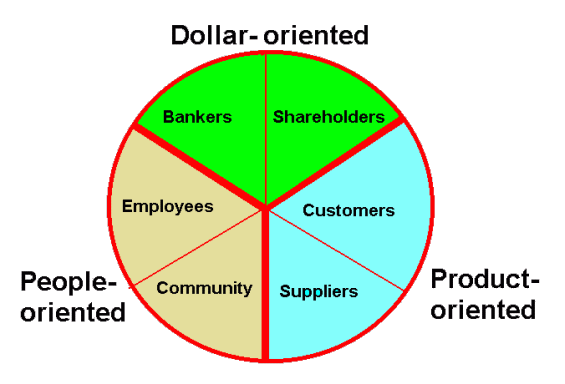|
Something to Think About
Stakeholders:
A stakeholder is anyone who gains by a company's existence and loses if the company goes out of business (e.g., goes bankrupt).
Contrary to what many people seem to believe, "shareholders" are only one segment of "stakeholders" in a company.
There are three (3) major segments of stakeholders, each involving a decidedly different primary focus:
Each major segment has two minor segments, for a total of six segments of stakeholders.
Stakeholders

|
Give and take partnerships
In all but one of the six minor segments, there is give-and-take on the part of both partners - i.e., between the company and the stakeholder(s).
| Segment |
Provide |
Receive |
| Customers |
Customers provide payment for company products. |
Customers receive products. |
| Suppliers |
Suppliers provide goods and services. |
Suppliers receive payment from the company. |
| Employees |
Employees provide, time, talent, skills, and knowledge. |
Employees received wages and benefits from the company. |
| Community |
The community provides infrastructure and the supporting environment. |
The community receives taxes, donations, etc. from the company. |
| Bankers |
Bankers provide short and long-term temporary funding. |
Bankers receive interest payments from the company. |
| Shareholders |
- 0 -
(Zero, Zilch, Zip, Nil, Nothing)<Note 1> |
|
The shareholders receive dividends from the company. |
Dollar-oriented stakeholders
The stakeholders in this segment are primarily (if not exclusively) interested in money (e.g., dollars). Virtually all interfaces between the company and members of this segment involve dollars.
- Shareholders
With the exception of initial public offerings (IPO), this sub-segment does not provide any (additional) money to the company. On an on-going basis, they only extract (receive) money ($$$) from the company in the form of periodic dividends - if the company so decides - and is capable of doing so.<Note 1>
- Bankers
This segment of stakeholders provides the major operating funds ($$$) for the company in the form of business loans, corporate bonds, lines of credit, etc. In return, they receive interest payments ($$$) from the company.
| <1> |
If you pay $10 per share to buy 1000 shares of "XYZ company" on the open market, the company does not get the $10,000. In fact, the company gets absolutely NOTHING.
You, on the other hand, get the right to receive a share of any dividends paid out.
You also get voting rights to help direct the company -- e.g., to demand short-term decisions which may help drive the (near-term) stock price up. Then, you can sell your shares and make a profit -- for yourself. (Again, the company would received nothing from the sale of your shares to a subsequent buyer.)
|
|
Product-oriented stakeholders
The primarily interface element for this segment of stakeholders are products (products the company uses and products the company produces.)
- Costomers
This sub-segment of stakeholders provides the market for the company's products. Without a market for the company's products, the company would have no reason to (nor ability to) exist. Customers provide the primary flow of money (on an on-going basis) to the company in exchange for the company's products.
- Suppliers
This sub-segment provides the company with needed goods and service, in exchange for with, the company pays these suppliers. The company is an important part of each supplier's business.
People-oriented stakeholders
This segment is primarily on people factors as they interface with the company.
- Employees
This sub-segment provides the needed labor and knowledge that enables the company to exist and function.
They do the work. The product the value added to the products of the suppliers to product the products of the company.
- Community
This sub-segment provides the services and infrastructure that enables the company to exist and operate. Roads, housing for employees, hospitals and other healthcare facilities, all sorts of social and other support facilities. This sub-segment provides the necessary environment and support to enable employees to be available to the company.<Note 2>
| <2> |
This segment also has to "pick up the tab" to help support employees whom the company lays off in order to preserve the stock price and executive bonuses*.
* See also how many.
|
|
|
|
-30-
|